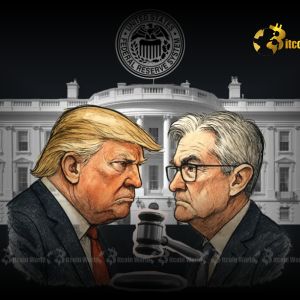Trump Fed Rate: The Alarming Call for Change in US Monetary Policy
8 min read
The financial world recently buzzed with a potent declaration from former U.S. President Donald Trump. According to a report by Walter Bloomberg on X, Trump asserted that the U.S. Federal Reserve’s interest rate stands at least three percentage points too high. This statement, while characteristic of Trump’s outspoken nature regarding economic policy, immediately sparks a crucial conversation about the current state of the economy, the role of central banks, and the potential ripple effects across global markets, including the volatile cryptocurrency market . For anyone tracking economic shifts, understanding the implications of such a significant critique of the Trump Fed Rate is paramount. What’s the Fuss About Trump Fed Rate Remarks? Donald Trump’s pronouncements on economic matters have always garnered significant attention, and his latest critique of the Federal Reserve is no exception. His assertion that the Fed’s interest rate is excessively high — by at least three percentage points — isn’t just a casual observation; it’s a direct challenge to the central bank’s current strategy. To put this into perspective, if the federal funds rate were, for instance, at 5.50%, Trump’s view suggests it should be closer to 2.50% or even lower. Such a drastic difference highlights a fundamental disagreement on the appropriate stance for US interest rates in the current economic climate. During his presidency, Trump frequently criticized the Federal Reserve, particularly its then-Chair, Jerome Powell, for not lowering interest rates enough or quickly enough. His consistent argument was that higher rates stifled economic growth, made U.S. exports less competitive, and increased the cost of government borrowing. This recent statement echoes those past sentiments, indicating a continued belief that the Fed is overly restrictive. The core of his argument often centers on the idea that lower rates would stimulate investment, boost the stock market, and reduce the burden of debt for businesses and consumers. The Federal Reserve, on the other hand, operates with a dual mandate: to achieve maximum employment and maintain price stability (i.e., control inflation). Their decisions on interest rates are a delicate balancing act, influenced by a myriad of economic indicators. Trump’s remarks, therefore, are not just about a number; they represent a philosophical divide on how best to manage the nation’s economic health. Understanding US Interest Rates: A Closer Look To truly grasp the weight of Trump’s comments, it’s essential to understand what US interest rates are and why they matter so profoundly. The interest rate Trump refers to is primarily the federal funds rate, which is the target rate for overnight lending between banks. While not directly what consumers pay, it serves as a benchmark that influences all other interest rates in the economy, from mortgages and car loans to business investments and credit card rates. When the Federal Reserve raises interest rates, it typically aims to cool down an overheating economy and combat inflation. Higher borrowing costs discourage spending and investment, which can reduce demand and, in theory, bring prices down. Conversely, lowering rates aims to stimulate economic activity by making borrowing cheaper, encouraging spending and investment. Several key factors influence the Federal Reserve’s decisions: Inflation Data: The Consumer Price Index (CPI) and Personal Consumption Expenditures (PCE) are closely watched. If inflation is persistently high, the Fed is more likely to keep rates elevated or even raise them. Employment Figures: Unemployment rates, job growth, and wage increases provide insights into the labor market’s health. A strong job market might give the Fed more room to keep rates higher without fear of a recession. Economic Growth (GDP): Gross Domestic Product indicates the overall health and growth trajectory of the economy. Slowing growth might prompt calls for rate cuts. Global Economic Conditions: International trade, geopolitical events, and economic performance in other major countries can also influence the Fed’s strategy. Trump’s call for a 3-point reduction suggests a belief that the current economic conditions warrant significant stimulus, or perhaps that inflation is sufficiently under control to allow for such a move without adverse consequences. This perspective often contrasts with the Fed’s more cautious, data-driven approach, which prioritizes long-term price stability. The Intricacies of Monetary Policy and Its Economic Impact At the heart of the Federal Reserve’s operations lies monetary policy , a set of tools used to manage the supply of money and credit to influence economic conditions. The federal funds rate is the primary lever, but the Fed also employs other strategies, such as quantitative easing (QE) and quantitative tightening (QT), to expand or contract the money supply. Trump’s critique directly targets the restrictive nature of the current policy. The economic impact of high interest rates is multifaceted and can be felt across various sectors: Borrowing Costs Soar: For businesses, higher rates mean more expensive loans for expansion, equipment, and operations. This can lead to reduced investment, slower job creation, and potentially lower profits. For consumers, mortgages become pricier, making homeownership less accessible, and credit card debt becomes more burdensome. Reduced Consumer Spending: With higher borrowing costs and potentially slower wage growth (due to reduced business investment), consumers might cut back on discretionary spending, which can dampen overall economic activity. Impact on Stock Markets: Higher interest rates can make bonds more attractive relative to stocks, as bonds offer a “risk-free” return. This can lead to a rotation out of equities, particularly growth stocks that rely on future earnings, which are discounted more heavily at higher rates. Currency Strength: Higher rates can attract foreign capital seeking better returns, strengthening the U.S. dollar. While a strong dollar makes imports cheaper, it makes U.S. exports more expensive, potentially hurting export-oriented industries. Government Debt Servicing: For a nation with a substantial national debt, higher interest rates mean a larger portion of the budget must be allocated to servicing that debt, potentially crowding out other essential government spending. The challenge for the Federal Reserve is to navigate these complex dynamics, aiming for a “soft landing” – bringing inflation down without triggering a severe recession. Trump’s perspective, however, suggests that the Fed is overshooting, risking an unnecessary economic slowdown by keeping rates excessively high. How Does This Affect the Cryptocurrency Market? While Trump’s comments directly address traditional financial markets, their potential implications for the cryptocurrency market are significant. The crypto space, known for its volatility, is highly sensitive to macroeconomic shifts and investor sentiment. Here’s how elevated US interest rates , and the debate surrounding them, can influence digital assets: Risk-Off Sentiment: Higher interest rates generally foster a “risk-off” environment. When traditional, less volatile assets like bonds offer attractive returns, investors tend to pull capital from riskier assets like cryptocurrencies and tech stocks. This is because the opportunity cost of holding volatile assets increases. Cost of Capital: For crypto companies, especially those in the development or expansion phase, higher interest rates mean that borrowing money for operations, innovation, or acquisitions becomes more expensive. This can slow down growth and development within the ecosystem. Liquidity Drain: As central banks tighten monetary policy , overall liquidity in the financial system tends to decrease. Less readily available capital can mean less money flowing into speculative assets like cryptocurrencies. Dollar Strength: If high U.S. interest rates lead to a stronger dollar, it can sometimes put downward pressure on Bitcoin and other cryptocurrencies, which are often priced against the dollar. A stronger dollar makes crypto more expensive for international buyers holding other currencies. Investor Behavior: The uncertainty surrounding Fed policy and economic forecasts can lead to cautious investor behavior. Trump’s remarks add another layer of political and economic debate, which can contribute to market jitters. If investors perceive that current rates are stifling economic growth, it could dampen enthusiasm for high-growth, high-risk assets like crypto. Historically, periods of aggressive rate hikes have often coincided with downturns in the crypto market. While correlation doesn’t equal causation, the macro environment undeniably plays a crucial role in shaping investor appetite for digital assets. A sustained period of high rates, or the perception that rates are unnecessarily high, could therefore continue to be a headwind for crypto. Navigating the Future: Actionable Insights for Investors In a landscape shaped by significant economic commentary and evolving monetary policy , what should investors, particularly those in the cryptocurrency market , consider? Trump’s remarks serve as a reminder that economic policy is a dynamic and often contentious arena, with real-world consequences for your portfolio. Here are some actionable insights: Stay Informed on Macro Trends: Beyond just crypto news, keep a close eye on Federal Reserve announcements, inflation data, employment reports, and significant political commentary. These macroeconomic indicators often provide the underlying current for market movements. Understand the “Why”: Don’t just react to headlines. Try to understand the rationale behind the Fed’s decisions and the arguments of its critics. This deeper understanding will help you make more informed investment choices rather than emotional ones. Diversification is Key: In times of economic uncertainty, having a diversified portfolio across different asset classes (not just crypto) can help mitigate risk. If one sector is under pressure from high interest rates, others might perform differently. Long-Term Perspective: For crypto investors, focusing on the long-term fundamentals of projects rather than short-term price fluctuations driven by macro headlines can be beneficial. The underlying technology and utility of blockchain might remain strong even during periods of economic headwinds. Assess Your Risk Tolerance: High interest rates and potential economic slowdowns can increase market volatility. Re-evaluate your personal risk tolerance and adjust your investment strategy accordingly. While Trump’s comments are just one voice in a complex economic dialogue, they underscore the ongoing debate about the appropriate level of US interest rates and their profound economic impact . For investors, particularly in the nascent and volatile crypto space, understanding these broader economic forces is crucial for making resilient decisions. Conclusion: The Enduring Debate on Economic Direction Donald Trump’s assertion that the Federal Reserve’s interest rate is “at least 3 points too high” reignites a critical discussion about the trajectory of the U.S. economy and the role of its central bank. This powerful statement, while controversial, highlights the deep divisions in economic thought regarding the optimal level of US interest rates and the most effective monetary policy to ensure both price stability and robust growth. The potential economic impact of current rates, whether perceived as restrictive or necessary, undeniably filters through every layer of the financial system, reaching even the dynamic cryptocurrency market . For investors and observers alike, staying attuned to these high-level economic debates, understanding their nuances, and recognizing their potential influence on asset classes remains essential in navigating the complex financial landscape. The debate over the Trump Fed Rate isn’t just about numbers; it’s about the fundamental direction of the American economy. To learn more about the latest crypto market trends, explore our article on key developments shaping US interest rates and their economic impact on cryptocurrency price action.

Source: Bitcoin World



